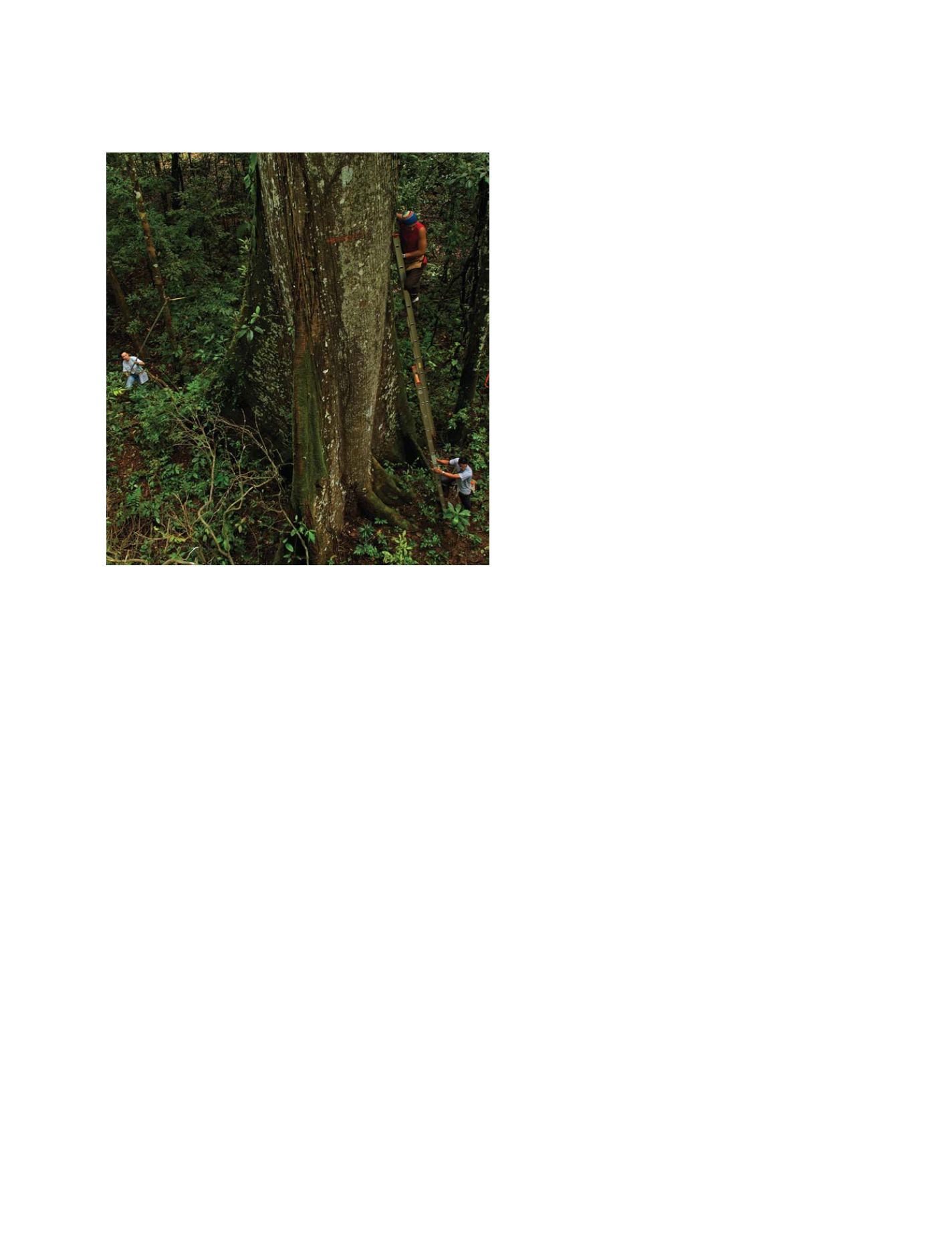

[
] 83
Global carbon research programme
Human activities have caused a 15 per cent increase in
atmospheric carbon dioxide in the past 40 years and
are set to increase atmospheric CO
2
levels even more
dramatically in the coming decades. This increase,
coupled with equally dramatic increases in other green-
house gases, is having a profound effect on global
climate, and on terrestrial and oceanic ecosystems.
Regrettably, there is a tremendous gap in our under-
standing of the role of forests in the global carbon
budget, and insufficient evidence on whether temper-
ate and tropical forests behave differently under
changing global conditions.
SIGEO plots provide in situ measures of above- and
below-ground carbon and how it is changing in response
to rising CO
2
. A recent publication by CTFS scientists
using data from two forest plots with measurements for
over 20 years (BCI, Panama and Pasoh, Malaysia) has
shown that despite increased carbon fertilization, growth
rates of tropical forest trees has decreased. This decrease
is perhaps a response to global warming. Rigorously
generated, long-term data from a global network of plots
will provide critical empirical data for modelling carbon
dynamics in the future. It will also provide direct
measurement of whether efforts to reduce carbon emis-
sions are effective.
Branching out into the temperate zone
Because of differences in seasonality, albedo and other
climate factors, tropical and temperate forests are antic-
ipated to behave differently with regard to changes in
atmospheric carbon dioxide levels and changing
temperatures. Currently no temperate-zone plots follow
the same methodology as the tropical plots but the
SIGEO initiative will take advantage of long-term forest
plot-associated research at the CRC of the Smithsonian
NZP and the SERC to quickly establish a series of large-
scale temperate plots that will permit direct comparison
to the tropical plot network.
Partnerships in temperate China and Europe are
being developed to help expand these temperate-trop-
ical comparisons to a global scale. HSBC has recently
formed a partnership with the Smithsonian Institution
and the Earthwatch Institute to establish a regional
training centre on climate change at SERC.
Scientists at SERC and CRC have a rich and produc-
tive history of conducting long-term environmental
studies such as measuring the effects of atmospheric
CO
2
on plant and soil microbial communities, biodi-
versity monitoring and assessment, landscape ecology,
and the biology of migratory birds.
Expanding the monitoring programme: looking
beyond the trees
Scientists from CRC, the NMNH, and STRI will signif-
icantly improve assessment of the impact of global
change on biodiversity through focused surveys of verte-
brates, invertebrates and microbes across the global earth
observatories. Standard methods for measuring and
The Smithsonian Institution is uniquely positioned to conduct
interdisciplinary research on complex biological systems at a global
scale. It will do this by expanding and deepening its collaborative
ventures among units including the National Zoological Park’s (NZP)
Conservation and Research Center (CRC), the National Air and
Space Museum (NASM), the National Museum of Natural History
(NMNH), the Smithsonian Astrophysical Observatory (SAO), the
Smithsonian Environmental Research Center (SERC) and STRI.
SIGEO will contribute to fulfilling the strategic plan of the US
Climate Change Science Program (CCSP) and addressing a proposed
CCSP priority of reducing scientific uncertainty about potential
effects of climatic change on ecosystems. Furthermore, the
Intergovernmental Panel on Climate Change (IPCC) Working
Group II assessment report has shown the great need for better
observational data on climate change impacts, and has particularly
pointed out the need for systematic and comprehensive observa-
tions that SIGEO will provide.
Finally, the Smithsonian is reaching out to build or strengthen
collaborations with government agencies of the United States includ-
ing the US Environmental Protection Agency (US EPA), US
Geological Survey (USGS), US Department of Agriculture (USDA)
Forest Service, National Oceanic and Atmospheric Administration
(NOAA) and the National Aeronautics and Space Administration
(NASA). Such efforts are focused particularly on the intergovern-
mental Group on Earth Observations (GEO) and the
implementation of the Global Earth Observation System of Systems
(GEOSS). The Smithsonian Institution is interested in expanding
the opportunities for collaboration and partnerships among agen-
cies to maximize the increase and diffusion of knowledge.
The Smithsonian will transform the CTFS network of tropical
forest plots into a system of SIGEO in three primary ways.
Researchers measuring trees at Barro Colorado Island, Panama
Photo: Marcos A. Guerra
GEOSS C
OMPONENTS
– O
BSERVING
S
YSTEMS
















